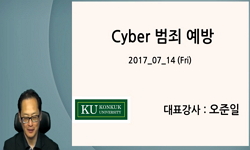사이버상에서 발생할 수 있는 범죄는 행위자가 누구이냐에 따라서 사인인 경우와 국가인 경우로 나눌 수 있고, 국가에 의한 사이버범죄는 정보전으로서 국가의 활동과 관련된다. 사인에 의...
http://chineseinput.net/에서 pinyin(병음)방식으로 중국어를 변환할 수 있습니다.
변환된 중국어를 복사하여 사용하시면 됩니다.
- 中文 을 입력하시려면 zhongwen을 입력하시고 space를누르시면됩니다.
- 北京 을 입력하시려면 beijing을 입력하시고 space를 누르시면 됩니다.
https://www.riss.kr/link?id=A77029871
- 저자
- 발행기관
- 학술지명
- 권호사항
-
발행연도
2003
-
작성언어
Korean
-
주제어
정보전 ; 정보작전 ; 국가의 범죄 ; 사이버범죄 ; 무력행사 ; 침략 ; 비살상무기 ; 컴퓨터바이러스 ; 해킹 ; 국제범죄 ; 보통범죄 ; use of force ; international crime ; information warfare ; non-lethal weapon ; computer virus ; hacking ; self-defence ; crime of state ; cybercrime ; aggression ; information operation
-
등재정보
KCI등재후보
-
자료형태
학술저널
- 발행기관 URL
-
수록면
159-192(34쪽)
-
KCI 피인용횟수
8
- 제공처
- 소장기관
-
0
상세조회 -
0
다운로드
부가정보
국문 초록 (Abstract)
사이버상에서 발생할 수 있는 범죄는 행위자가 누구이냐에 따라서 사인인 경우와 국가인 경우로 나눌 수 있고, 국가에 의한 사이버범죄는 정보전으로서 국가의 활동과 관련된다. 사인에 의한 사이버범죄는 행위지와 결과발생지가 각각 다름으로 인하여 형사관할권의 문제, 죄형법정주의의 문제 및 형사사법공조의 문제가 있다. 반면에 정보전은 악성 컴퓨터프로그램으로 행한 다른 국가의 컴퓨터네트워크에 대한 공격이 UN헌장 제2조 4항에서 금지하고 있는 무력행사에 포함되는지 여부이다.
전시에 행해지는 정보전은 전쟁의 수단과 방법의 일부분으로 볼 수 있으므로 평시에 전개되는 정보전으로 한정하면, 첫째, UN헌장 제2조 4항에서 금지하고 있는 무력행사의 의미가 기동력이 있는 물리적인 힘으로 표출되는 다양한 형태의 군사활동으로 볼 수 있다. 둘째, 다른 국가의 컴퓨터네트워크에 대한 공격도 4가지의 근거 및 5가지의 전제조건하에 무력의 행사로 볼 수 있다. 셋째, 침략의 정의에 관한 UN총회의 결의에 따르면 최초의 무력의 행사는 침략 개시의 증거로 보고 있으므로 다른 국가의 컴퓨터네트워크에 대한 공격이 무력행사를 의미할 때 그것이 침략행위를 의미하는지 의문이 제기된다. 넷째, 컴퓨터바이러스는 비살상무기로 분류되고, 비살상무기로 침략행위가 개시된 사례가 없으므로 컴퓨터네트워크에 대한 공격 그 자체는 침략행위로 보기 어렵다. 다섯째, 다른 국가의 컴퓨터네트워크에 대한 공격이 5가지의 조건하에 무력의 행사로 본다고 하더라도 비례성의 원칙에 견지에서 보면 재래식무기로 자위조치도 할 수 없다. 여섯째, 현재까지 사이버공격으로 발생한 문제는 인명살상이 아니라 물질적 손실로 한정되고 또 모든 국가가 국제분쟁의 평화적 해결의무를 부담하고 있으므로 평화적인 방법으로 해결할 수 있다. 일곱째, 구체적으로 사이버공격과 관련된 범죄행위는 국제불법행위로서 국가책임과 개인에 대한 형사책임의 이론으로 처리가 가능하다.
현행 국제법의 패러다임은 주권과 영토의 개념이 전제가 된 국가를 기초로 한 구조로 되어 있다. 이러한 패러다임은 가상의 공간에서 또는 가상의 공간을 통하여 발생할 수 있는 국가의 범죄에 관련된 문제는 현행 국제법으로 규율할 수 없다. 따라서 인터넷을 통하여 형성된 사이버공간에 대한 새로운 패러다임의 형성이 필요하다.
다국어 초록 (Multilingual Abstract)
Cyber criminals can be grouped into state-actors and non-state actors. There are three main issues involved for non-state actors who attack a computer system or network on foreign soil because the place to be committed a crime and the place to be occu...
Cyber criminals can be grouped into state-actors and non-state actors. There are three main issues involved for non-state actors who attack a computer system or network on foreign soil because the place to be committed a crime and the place to be occurred the result of the crime are different states respectively. These are ① which country has criminal jurisdiction?, ② the issue of nulla poena sine lege, and ® the issue of mutual assistance in criminal matters. Cybercrime committed by a state-actor can be referred to information warfare(IW). The main issue in information warfare from the standpoint of international law is whether computer network attack(CNA) of any state by a state-actor can be considered as "the use of force" prohibited in Article 2(4) of U.N. Charter.
During wartime, IW is a part of means and method of armed conflict. However, it is questionable whether it can be considered as a means of armed conflict during peace time. In this paper, I discuss this issue with the following seven points. First, the term of use of force prohibited in Article 2(4) of U.N. Charter is armed force described as various forms of kinetic or physical force related to military activity of a state. Second, CNA can be included the meaning of use of force under the four grounds and five pre-conditions. Third, the use of force is, in itself, aggression in accordance with Article 2 of Definition of Aggression(XXIX) under the Resolution of U.N. General Assembly, which prescribes, "the first use of force by a state in contravention of the Charter shall constitute prima facie evidence of an act of aggression…. However, the arising question is whether CNA is considered the act of aggression if CNA meets the five pre-conditions to be considered as "the use of force". Fourth, CNA can not be act of aggression because of two facts. One is that malicious computer-program such as 'I Love You virus' and hacking programs which deny, destroy, corrupt, or exploit the enemy's information and its functions can be categorized non-lethal weapon. The other is that there is not even a case to have invaded with non-lethal weapon. Fifth, it is not legitimate to invoke the right of self-defence using conventional weapons against CNA in the light of the principle of proportion even though CNA is contained the meaning of use of force under five pre-conditions. Sixth, the problem raised by the attack through cyberspace can be solved by peaceful means because damage occurred is only limited by economic loss, not casualties, and all countries should be imposed the obligation of pacific settlement of disputes under Chapter Ⅵ of U.N. Charter as well. Finally, the act of crime related to CNA can be composed of state responsibility as an international wrongful act, and the actor of the crime who hold a position as an official capacity such as a Head of State or Government can be punished with the theory of individual criminal responsibility.
Current paradigms of international law focus on a state-based structure that is preoccupied with the notions of sovereignty and territory. The problems raised through cyberspace or in the cyberspace can not be applied to current international law. So, tomorrow's world will require new paradigms which accommodate the imminent transnational society through Internet.
목차 (Table of Contents)
- Ⅰ. 서론
- Ⅱ. 국제법상 정보전에 관한 고찰
- Ⅲ. 다른 국가의 컴퓨터네트워크에 대한 공격이 무력행사인지 여부
- Ⅳ. 무력행사로 간주되는 컴퓨터네트워크에 대한 공격이 침략행위인지 여부
- Ⅴ. 결론 : 문제의 해결 방향 및 제언
- Ⅰ. 서론
- Ⅱ. 국제법상 정보전에 관한 고찰
- Ⅲ. 다른 국가의 컴퓨터네트워크에 대한 공격이 무력행사인지 여부
- Ⅳ. 무력행사로 간주되는 컴퓨터네트워크에 대한 공격이 침략행위인지 여부
- Ⅴ. 결론 : 문제의 해결 방향 및 제언
- 국문초록
- ABSTRACT
동일학술지(권/호) 다른 논문
-
- 대한국제법학회
- 이성덕(Seong-Deog Yi)
- 2003
- KCI등재후보
-
- 대한국제법학회
- 편집부(편집자)
- 2003
- KCI등재후보
-
- 대한국제법학회
- 都時煥(See-Hwan DOH)
- 2003
- KCI등재후보
-
- 대한국제법학회
- 金民瑞(Min-Seo Kim)
- 2003
- KCI등재후보
분석정보
인용정보 인용지수 설명보기
학술지 이력
| 연월일 | 이력구분 | 이력상세 | 등재구분 |
|---|---|---|---|
| 2022 | 평가예정 | 재인증평가 신청대상 (재인증) | |
| 2019-01-01 | 평가 | 등재학술지 선정 (계속평가) |  |
| 2018-12-01 | 평가 | 등재후보로 하락 (계속평가) |  |
| 2015-01-01 | 평가 | 등재학술지 유지 (등재유지) |  |
| 2011-01-01 | 평가 | 등재학술지 유지 (등재유지) |  |
| 2009-01-01 | 평가 | 등재학술지 유지 (등재유지) |  |
| 2007-01-01 | 평가 | 등재학술지 유지 (등재유지) |  |
| 2004-01-01 | 평가 | 등재학술지 선정 (등재후보2차) |  |
| 2003-01-01 | 평가 | 등재후보 1차 PASS (등재후보1차) |  |
| 2002-01-01 | 평가 | 등재후보학술지 유지 (등재후보1차) |  |
| 1999-07-01 | 평가 | 등재후보학술지 선정 (신규평가) |  |
학술지 인용정보
| 기준연도 | WOS-KCI 통합IF(2년) | KCIF(2년) | KCIF(3년) |
|---|---|---|---|
| 2016 | 0.68 | 0.68 | 0.67 |
| KCIF(4년) | KCIF(5년) | 중심성지수(3년) | 즉시성지수 |
| 0.66 | 0.62 | 0.869 | 0.25 |





 DBpia
DBpia







